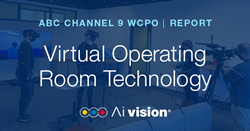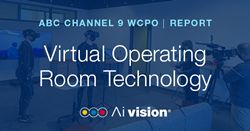
As the world sees the value and embraces artificial intelligence, this type of technology will become crucial in order to train and test those algorithms to be completely helpful, safe, and unbiased
CINCINNATI (PRWEB)
January 30, 2021
WCPO Channel 9 reporter Lisa Smith put on the VR headset and was instantly transported into a virtual operating room, complete with patient, surgeons, and the latest medical instruments.
Her story presents a deep dive into Kinetic Vision’s latest technology, AiVision Simulate, which is a Digital Twin software platform that utilizes motion capture (mocap), virtual reality, and game engine technology.
To watch the Channel 9 news story click HERE.
The system creates an infrared matrix that captures the user’s every motion, down to their fingertips, and transfers that motion to digital avatars in the virtual environment, or “digital twin.” Digital twins have existed in various forms for a few years, but Kinetic Vision’s breakthrough is the incorporation of real human action and interaction into the process.
In addition to medical applications, Kinetic Vision’s Machine Learning + Training Data group is applying this technology to a number of industries, from consumer retail, where store shopping behavior is analyzed, to aviation, where the ergonomics of controls are being studied.
“We created this system to optimize current surgical procedures and devices, and speed the development of new innovations. It’s much faster and less expensive to test digitally versus utilizing real rooms, equipment, and people. In the not-too-distant future, this system will be expanded to test, train, and perfect a much wider range of human activities, from building construction to conducting experiments on the International Space Station,” said Jeremy Jarrett, Executive Vice President of Kinetic Vision.
As AI (artificial intelligence) becomes ubiquitous in almost all aspects of product development, manufacturing, quality control, and distribution, the data to train machine learning models will become more valuable, but harder to create. Digital twins solve this conundrum by being accurate enough to be used for the creation of synthetic training data, which enables AI systems to be developed, tested, and optimized within the virtual twin. By incorporating real-time human behavior, Kinetic Vision has evolved the digital twin concept into a true digital representation of reality.
“As the world sees the value and embraces artificial intelligence, this type of technology will become crucial in order to train and test those algorithms to be completely helpful, safe, and unbiased,” said Jarrett.
Share article on social media or email:

